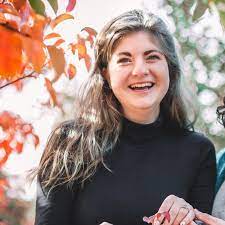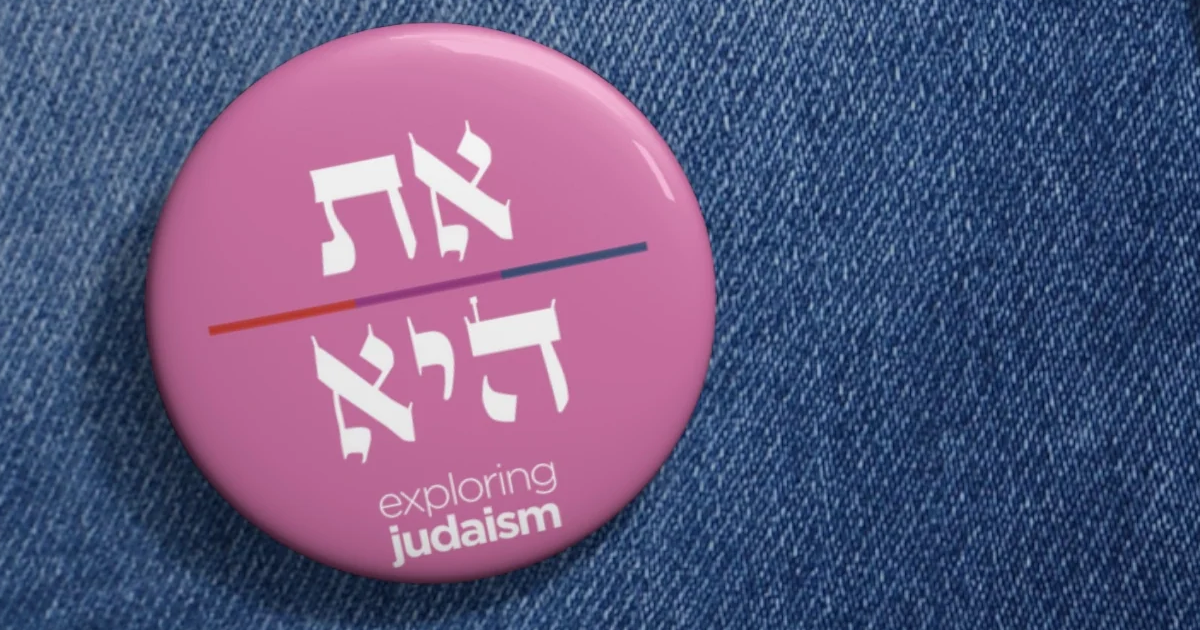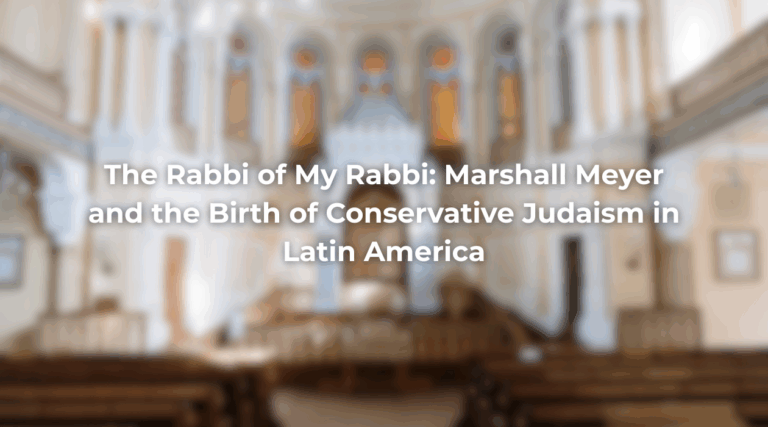Seeing ourselves in Torah
Exploring Judaism released our Hebrew Pronoun Pins earlier this year, and they’ve been a hit! We have four different pronoun sets (plus a blank option for write-ins) in six colors, with an option to buy in bulk for welcome tables, events, and conferences. For those interested in how these came to be, curious about why they are necessary, or just avid readers, we’re sharing a little bit about our process and how we are spreading TorahRefers to the first five books of the Hebrew Bible, the Tanakh, also called the Five Books of Moses, Pentateuch or the Hebrew equivalent, Humash. This is also called the Written Torah. The term may also refer to teachings that expound on Jewish tradition. Read more with these pins.
The Point of the Pins
You may have noticed pronouns popping up everywhere recently; these days, it’s common to see them included in email signatures, Zoom names, social media profiles, and name tags. The practice of using pronouns as identifiers next to our names comes with some complications, but there’s no denying that the widespread adoption of this trend has impacted our culture in two key ways:
- It sparks a conversation about pronoun use and the broad spectrum of gender experience, and
- It creates space for folks who want or need to share their pronouns with less stigma.
Our goal in making Hebrew Pronoun Pins is to bring that conversation further into Jewish spaces, so that we as a community can affirm the belonging of Jews of all gender expressions and consider the unique ways in which gender and pronouns function in our Jewish spaces.
Grappling with gendered language is a common part of the queer experience; it goes beyond personal pronouns and includes the way crowds are addressed (“ladies and gentlemen”), titles (husband, sister, fireman, Ms.), and how frequently English speakers use “gender” and “sex” interchangeably as synonyms.
Confronting the prevalence of gendered language is difficult enough in a non-gendered language like English, in which nouns, adjectives, and articles do not have genders. Queer Jews experience the added challenge of confronting these same challenges and more in Hebrew, a language in which few of us are fluent or native speakers and in which every word has a grammatical gender.
Pinpointing the Inspiration
The spark for these Hebrew Pronoun Pins came to me at Atlanta Pride in 2017. It was my first ever Pride march, and I was there with a group from Hillel. It was hot, even in October, and I had just moved to the city for my junior year of college. I didn’t know anyone very well, so by the time we came to the end of the parade route, I had wandered off alone to look at all the booths.
One of the vendors had baskets of pronoun pins out for grabs, and it was there that I saw a write-in pronoun option for the first time. I took one blue pre-filled pronoun pin and one yellow blank pin, and carefully added Hebrew pronouns in block script with the provided Sharpie. That little yellow handwritten Hebrew pronoun pin has been with me since then.
This year, the regression in gender inclusion we are experiencing has been relentless. The attacks on women, on trans and nonbinary identity and bodies, and genderqueer experiences are never-ending. With the inundation of negativity I was looking for an opportunity to bring a little queer joy into the world, and my faded yellow pronoun pin sparked an idea.
Pinning Down the Problem
The issue of pronouns in Hebrew is a topic of frequent discussion in queer Jewish spaces because Hebrew is an anchor in Jewish culture. It links us to our long history of devotion to text, it binds us to each other across the globe, and it tethers us to our roots and our future in the land of Israel. It is the language of our past and our future, even as we struggle with it as the language of our present.
The challenge of gendered language in Hebrew often comes up when discussing Bnei Mitzvah experiences. Many of our students struggle with how to refer to themselves as they became Bnei Mitzvah in a way that honors themselves and the traditions of their families.
A similar tension is present when being called to the Torah, or getting married, or being named in a Mi SheBeirach, all of which are times when our liturgy identifies us by gender. Some queer Jews, particularly those who ‘came out’ or transitioned after a major life event or simcha, express that their memories of the occasion are tinged with bittersweetness or even angst, because of how difficult it is to claim both who they are today and how they were presented then.
Being identified by our gender in moments when we should be able to be our most authentic selves presents a deep discomfort and sometimes even a barrier for many of the queer Jews in our community. We have an obligation to find new ways to address this challenge so that each member of our community is able to participate to the fullest.
Despite these challenges, gender expression and gender diversity are not foreign concepts to Judaism, nor are they new topics of exploration.
There are at least six genders recognized in the TalmudReferring to one of two collections, the Jerusalem and Babylonian Talmuds, edited in the 6th century, that contains hundreds of years of commentary, discussion, and exploration of the ideas in the Mishnah. One could describe it as Mishnah + Gemara = Talmud Read more. God’s own gender expression – or at least, the way we express God’s gender – is varied, and includes feminine language and masculine language as well as a mix unique to Godself. Sometimes we intentionally gender God to contextualize God in our own experiences, sometimes God is too beyond ourselves to be gendered.
There is a vital and growing tradition of scholarly queer and genderqueer Torah right now that is beautiful and complex, joyful and full of angst, and all the things we hope our Torah learning might be.
Exploring Judaism’s Pronoun Pins: See Yourself in Torah
The Pronouns
Language is a living, fluid thing, and gender carries different meaning and functions differently in gendered languages like Hebrew than it does in non-gendered languages like English. Social gender and grammatical gender are different concepts, but it is difficult to separate the influence of one on the other, especially when looking from the outside in as an English speaker considering a language with grammatical gender.
Language is intensely personal and inherently public – it is the most expressive way we have of relating to each other. It changes us, and we change it. Language can be used to reflect our values when it comes from native speakers, and it can be used to enforce outside values when it is changed or restricted from the outside.
With this in mind, it was crucial for us to defer to native Hebrew speakers who are connected to Hebrew-speaking queer community to create a list of pronoun sets that accurately reflect how our language is being adapted to express queer identities.
We consulted with Rabbi Idit Lev, Global Engagement Associate at the Rabbinical Assembly, and Rabbi Maayan Belding-Zidon, Director of Religious Services at Masorti Israel, to decide which pronoun sets we should include and select the best “identity” terms to use on our queer identity stickers.
The Pins
We designed these pins with a font that reflects the script of the Torah scroll to recognize the rich and ongoing tradition of exploring gender expression in Judaism. After narrowing it down to a modern sans serif and the beautiful Torah style Shlomo Stam, Rabbi Mordechai Rackover said: “I like the idea of presenting ‘my identity in Torah,’” and that was it.
This phrase, ‘my identity in Torah,’ encapsulates the heart of the work that we do at Exploring Judaism, and, I hope, in our Jewish communities offline. Finding ourselves in Torah, seeing ourselves reflected there; it is an irreplaceable part of what makes us Jewish.
We’ve since leaned into the use of Torah style font and text decorations (tagin in Aramaic, ketarim in Hebrew, both meaning ‘crown’) as a representation of Exploring Judaism’s work. They are a prominent feature of our new logo, and a reminder that the work we do is the work of Torah.
The Last Point
I am grateful that these Hebrew Pronoun Pins are out in the world now, and I’m thrilled that they have resonated with so many. I am so proud to work for an organization that recognizes and participates in this important work.
If these pins challenge you, let them be a conversation starter.
If they inspire curiosity, let your questions be a means of connecting to each other.
If they move you, let them be a sign of acceptance and pride.
Our Jewish community is made better when we make it a better place for each of us.
A note on capital ‘P’ Pride, Pride Month, and Pride merch
I’m queer all year, and I think it’s safe to say most folks who are LGBTQA+ feel the same. I love celebrating Pride Month in June because it honors the Stonewall Riots and the Obergefell decision, which federally legalized same-sex marriage almost exactly 46 years later.
At the same time, I am keenly aware of how ephemeral support for queer community feels when it is distilled into rainbow corporate logos and LinkedIn profiles for only four weeks of the year. I am happy to dwell in the duality of appreciation and challenge here – it is one of the great blessings of being queer and Jewish – so these are technically Pride merch, but I hope to see these Hebrew Pronoun Pins out in Jewish spaces well after July 1.
Author
-

Briley is a Jewish educator with an eye for organization and a passion for making Judaism more accessible, relevant, and meaningful to all members of our community. Briley grew up in the Conservative/Masorti Jewish community of Tennessee and is currently a student at Ziegler School of Rabbinic Studies and lives in LA with their partner and twin toddlers.
As Exploring Judaism's Project Manager, Briley works closely with each member of the Exploring Judaism team to ensure that our projects run smoothly and meet the needs of our community.
View all posts




